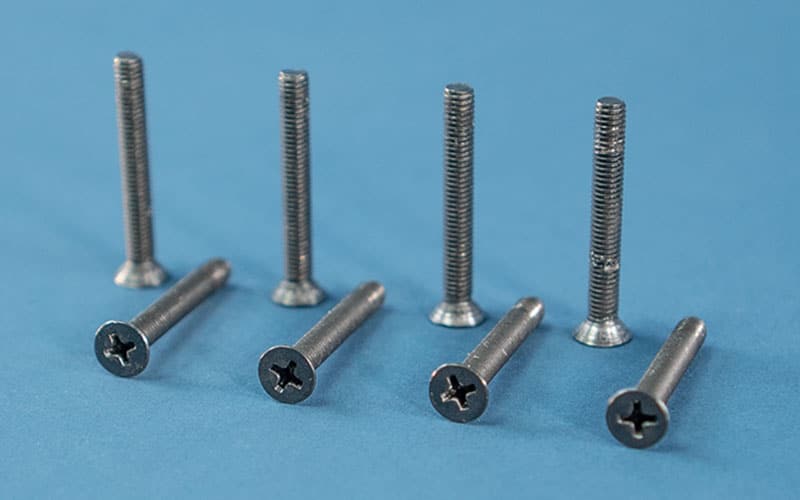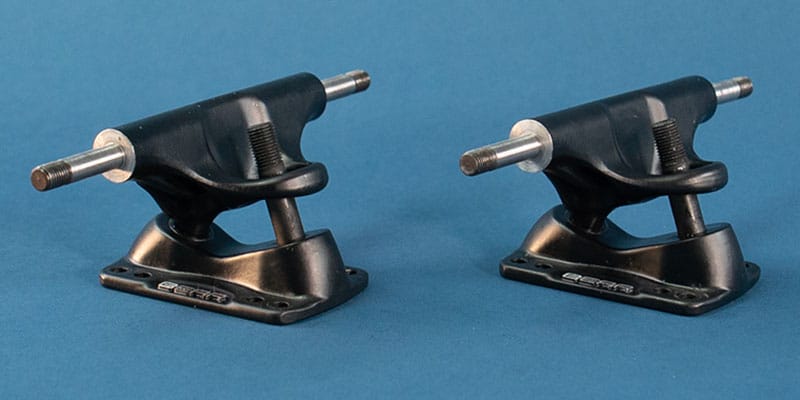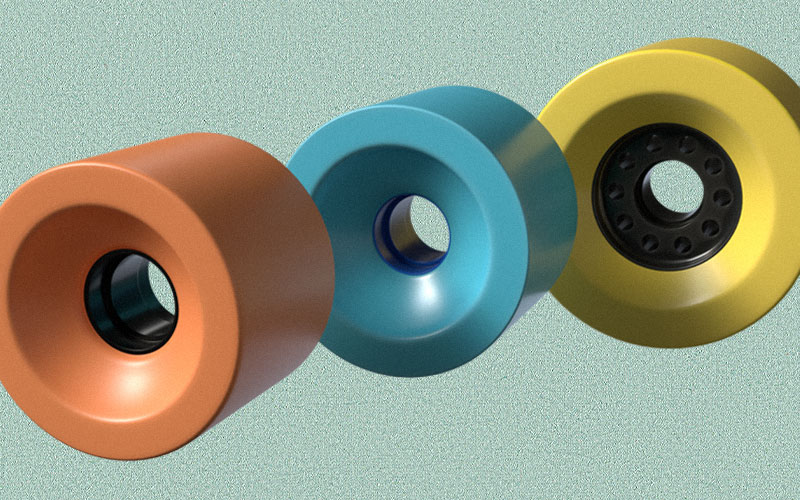Learning about the parts of a longboard can feel overwhelming.
In this article, we’ll cover the basics, to give you a solid foundation for progressing.
Let’s start with the…
Deck
The primary function of a longboard deck is to provide a stable platform for riders to stand on and maneuver the longboard. It serves as the foundation and supports the other components, such as trucks, wheels, and bearings.
They’re most commonly made of 7 or 8 veneers of Canadian maple, but some are even made with bamboo, urethane, plexiglass, carbon fiber and the list goes on.
Decks come in many different shapes, depending on the riding style.

Concave
The rail-to-rail curve is called concave. It can be mellow or steep, which really comes down to personal preference. If you’re just starting, getting a setup with mellow concave is a good place to start because steeper concave can be uncomfortable. Generally steeper concave is more functional for tricks or to lock you in when do deeper carving styles.
Camber
If it’s an upward bend, that’s called camber, which can add a lively flex and responsiveness to your ride. This is because the arch provides a spring-like effect, rebounding during turns and carves. Camber can also provide a comfortable and smooth cruising experience, as the flex can absorb vibrations.
Rocker
If it’s a downward bend, that’s called rocker, which makes your setup turn a bit sharper. This is because it acts as a wedge and changes the angle of your trucks. Rocker can also make pushing easier since the center of the deck will be lower to the ground.
Kicktail & Nose
Kicktails and noses are the upward curves at the ends of the deck. They’re functional for tricks, maneuvering, or leverage for deep carving styles. Again, a personal preference thing, but for most tricks, you need a kicktail.

Then there’s the grip tape, which is the rough, sandpaper-like texture on the top of your deck. It helps stop your feet from slipping while you ride.
There are a few types…
- Griptape sheets (most common)
- Spray on (which looks cool but will wear down faster)
- Built-in (like the Lander La)
The grit refers to the roughness of the grip tape. Think of it like sandpaper: the higher the grit number, the finer and smoother it is, while a lower grit number, the coarser and rougher it is.

By entering your email address you agree to receive emails from Concrete Waves. We'll respect your privacy and you can unsubscribe at any time.
Hardware
The hardware is the bolts and nuts that hold your board together.
The standardized sizes are…
- 10-32 Bolts
- 10-32 (Baseplate Nuts)
- 5/16″- 24 (Wheel Nuts)
- 3/8″- 24 (Kingpin Nuts)
Longboard setups commonly use countersunk/button, phillips or socket head bolts. Countersunk bolts will sit flush, which are best for flip tricks or barefoot riding. Button heads are structurally stronger.
It’s important that your nuts have a plastic lock ring, often referred to as nyloc. This will prevent them from loosening. So make sure that whenever you put these on, the bolt threads through and engages the nyloc, otherwise it might loosen and fall apart.
There are several characteristics when it comes to hardware, like sizes, head types, and materials.

Riser Pads
Riser pads are put on a setup for two reasons. The main one is to prevent wheelbite. The other is to wedge or dewedge your setup with angled riser pads. Wedging and dewedging can make your longboard more carvey or stable, depending on how you set it up.
Trucks
There are three common types of trucks that you’ll find on longboards.
- Reverse Kingpin (RKPs)
- Traditional Kingpin (TKPs)
- Double Kingpin (DKPs)
Most longboard setups will have reverse kingpins because their baseplate angles are lower, making them more stable at higher speeds. Some use traditional kingpins for a more nimble, carvey experience (like the Landaychtz Dipper).
Double kingpins are commonly found on carving longboard setups or electric skateboards since they sit the highest off the ground.

Bushings & Washers
Bushings are cylindrical pieces of polyurethane that sit on the kingpin, allowing your trucks to pivot. Bushing shapes and hardness will determine how your trucks feel and ride.
Most commonly they come in barrel and cone shapes. Basically barrel shapes have more resistance while cone shapes have less resistance.
A combination of barrel and cone are the most common. More stability, pair barrels together. More carving, pair cones together.
The metal washers sit on the bottom and top of the bushings to give them structure/ help rebound.
The two most common types are cup and flat. Cup washers are the most common and offer more support. Flat washers offer less support.

Wheels
Longboard wheels are made of polyurethane, a type of plastic material. Polyurethane has many characteristics similar to rubber and plastic, but unlike rubber, polyurethane has a higher rebound and hardness than plastic.
The wheels are important because they directly connect with the pavement and translate that feeling to you. They come in many different shapes and sizes. On average, they range from 65mm-85mm in size and 75a-85a durometer.

Bearings
Bearings are the metal components that sit inside the wheels and make them spin.
While there are many variations, it really boils down to two types.
Those that have all of the components built-in and those that have separate spacers and speed rings.
The main thing I wish I knew about bearings when first starting is that they’re not as important as you might think.
If you feel like your setup is sluggish, it’s most likely your wheels. Unless your bearings are old and rusted, don’t put too much weight on them.
Keep them maintained, and even cheap bearings can last a long time. Avoid double metal capped bearings if you intend on doing any maintenance.

Riser Pads
Risers pads are like lift kits or can manipulate the riding feel of your setup.
Regular riser pads increase the distance between your wheels and the deck to help prevent wheelbite.
They also make these, which are angled riser pads. If you face the thick part toward the center of your board, it will increase the angle of your truck and make it turn sharper.
And if the thick part faces the kicktail or nose, it will decrease the angle of your truck, adding more stability.



